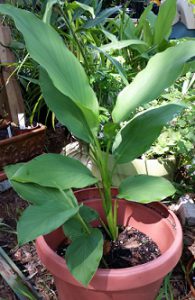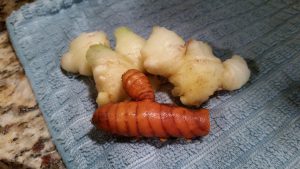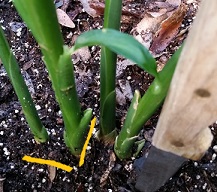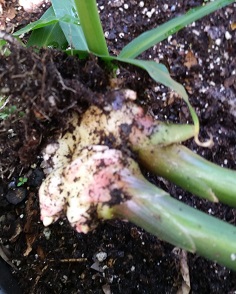
Here in South Florida there are many species of spices we can grow in our gardens. Ginger, Zingiber officinale, and Turmeric, Curcuma longa, are just two popular spices that can grow well in our Florida gardens. Both are beneficial in the kitchen and possibly in the medicine cabinet. There is currently ongoing research into the anti-inflammatory properties of both Ginger and Turmeric and the anti-nausea properties of ginger.
Ginger in the Florida Garden

There are many species of Ginger, most of which are ornamental. The ginger we use as a spice is Zingiber officinale. Though some ornamental varieties are reported to also be edible, I’d stick with the official ginger as its flavor is superior for cooking.
Turmeric, Curcuma longa, has as many as 80 varieties in its native lands of Southeast Asia. However, we are limited to what is available here in the United States.
Ginger and turmeric need shade, humidity, and good loamy soil. My plants are kept in large pots under an untrimmed Sabal Palmetto and an oak for this reason. But they could be tucked into the ground in a shady spot with loamy soil.
How Do I Choose Ginger and Turmeric at the Store?
Both ginger and turmeric are grown from the rhizomes which are available in grocery and health food stores. When choosing ginger to grow or to eat, you want a firm, slightly shimmery taupe-colored rhizome which is plump and not wrinkled and has no mushy or dark brown spots. Note: freshly dug ginger root is pale cream in color as it has not yet developed a taupe-colored “skin”.

Turmeric rhizomes are similar though thinner and are darker, more orange-blond than ginger. They usually are narrower and have a more linear growth habit with close-set leaf scars giving them a serpentine appearance.
How do I Grow Ginger and Turmeric?
It is best to plant ginger and turmeric rhizomes in spring to early summer. Choose roots as described above. Wash the rhizomes when you are ready to plant them. Some suppliers spray their root crops with growth retardant to keep them from sprouting in transit and while awaiting purchase. These retardants will hinder the growth of your ginger and turmeric plants.
Place the rhizomes on top of the soil where you would like to grow them and lightly cover them with more soil. Water frequently till summer rains begin. They like to be moist but once established they can tolerate a short dry period. Turmeric is especially slow to start but will take off with green shoots in a month or two. By July you should be able to use some freshly dug ginger. Harvesting turmeric should wait till all the leaves turn completely brown in the fall.
In late summer to early fall, turmeric leaves will begin to die back. Ginger will do the same a bit later. This is a normal part of the growth cycle of both plants and has to do with shorter daylight hours as we move into fall rather than temperature or lack of water. Once the

leaves die off, you can harvest all the rhizomes. You may leave a few ginger rhizomes in their pot for the winter and these will sprout again next spring. Once harvested, store ginger root and turmeric in a dark, cool, dry place indoors.
How do I Use Fresh Ginger and Turmeric?

You can harvest ginger any time during the growing season once the plants have three or more growing stems. Choose two shoots which are heading out from the others. With a serrated knife, slice down into the soil between the growing stems to separate the chosen two from the rest of the plant shoots. Gently pull up the two shoots, being careful to keep cutting if they don’t come up easily.

After pulling up the stems, roots and all, snap off all leaf stems and any tiny roots, which can be added to your compost. Be sure to clean away all the little pink leaf bases as they can be tough.
Turmeric is harvested much the same way but should be left to grow till the leaves all turn brown in the fall. Discard brown leaves and gently dig, trying not to break up the rhizomes as you loosen them from the soil.
Under running water, gently scrub away any remaining soil with your fingertips, being sure to get between the rhizome ‘fingers’. A soft toothbrush works well for this task.

Let dry at room temperature. Peel the rhizomes with the side of a spoon to remove skin (if present). Rinse again. Slice or grate with the fine side of the grater as needed. Store remainder in a cool, dark, dry place to be used as needed throughout the winter and spring.
Recipes Using Fresh Ginger and Turmeric
The most flavorful part is directly under the skin so be careful when peeling. Freshly dug summer ginger has not developed skin yet so skip the peeling if the ginger is creamy beige in color as in the photo to the right. Fresh ginger can be grated into a simple stir-fry marinade of soy sauce and minced garlic, a one-inch piece will do and run through the garlic press. You can slice fresh ginger into hot tea or chop finely for Fresh Ginger Cookies. We make a Ginger simple syrup for the holidays with 2 cups each of thin ginger slices, sugar and water. Boil for 8 minutes, remove from heat, cool, and strain. Store in the refrigerator for up to a month. This syrup may also be water-bath canned and kept for a year. We pour it over ice cream, into seltzer, or use it in marinades. The ginger slices left from the process of making the syrup can then be dried and rolled in sugar for Candied Ginger.
Golden milk is a very tasty Caribbean beverage made with both fresh ginger root and turmeric root. It is simultaneously spicy, creamy, and intensely yellow in color. Yes, you may buy an instant mix but it is oh so much better homemade with all of its enzymes. NOTE: Cut turmeric root WILL stain anything with which it comes into contact- wear gloves while handling.
Golden Milk
- 2 cups coconut milk (or almond, soy, or cow’s milk)
- 1/2 tablespoon peeled, grated fresh ginger root
- 1/2 tablespoon peeled, grated fresh turmeric root
- 3-4 black peppercorns, ground
- Pinch ground cardamom (nutmeg or cinnamon may be added)
- Raw Honey or sweetener to taste, if desired
Heat first 5 ingredients and simmer for five minutes. Remove from heat to stand for 10 minutes. Stir in honey if using or sweeten to taste with your preferred sweetener. Strain into cups and serve warm or chill for later. Contains no caffeine.
NOTE: Turmeric can have interactions with anticoagulants. If you are taking any blood thinning drug or have any health concerns, be sure to consult your doctor before consuming any food or drink containing turmeric.
For more research-based information on growing ginger, the University of Florida’s Electronic Data Information Source (EDIS) has a publication entitled, “Ginger- Zingiber officinale Roscoe1″ which describes edible ginger, its culture, care, and harvesting.
Here is a link to the University of Florida’s Gardening Solutions web page on turmeric: https://gardeningsolutions.ifas.ufl.edu/plants/edibles/vegetables/turmeric.html
 1
1
